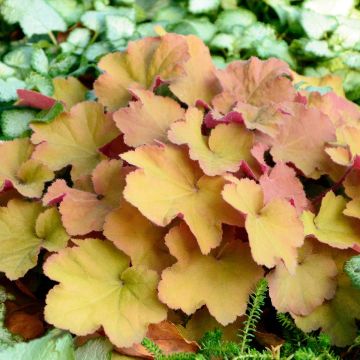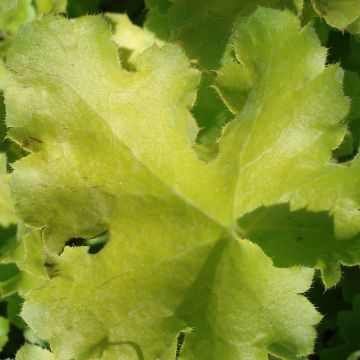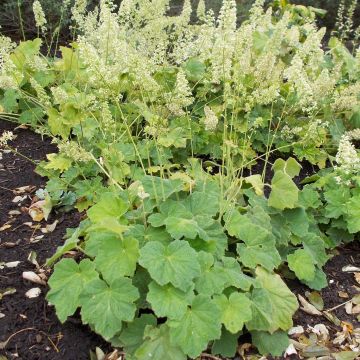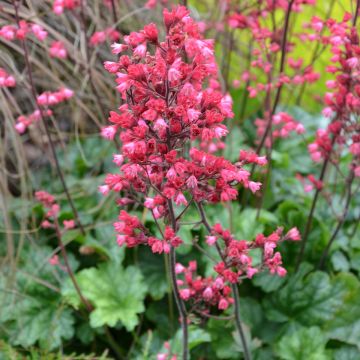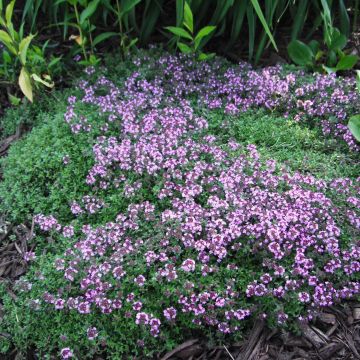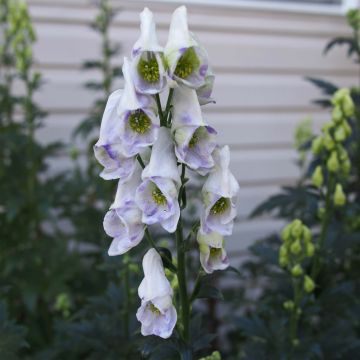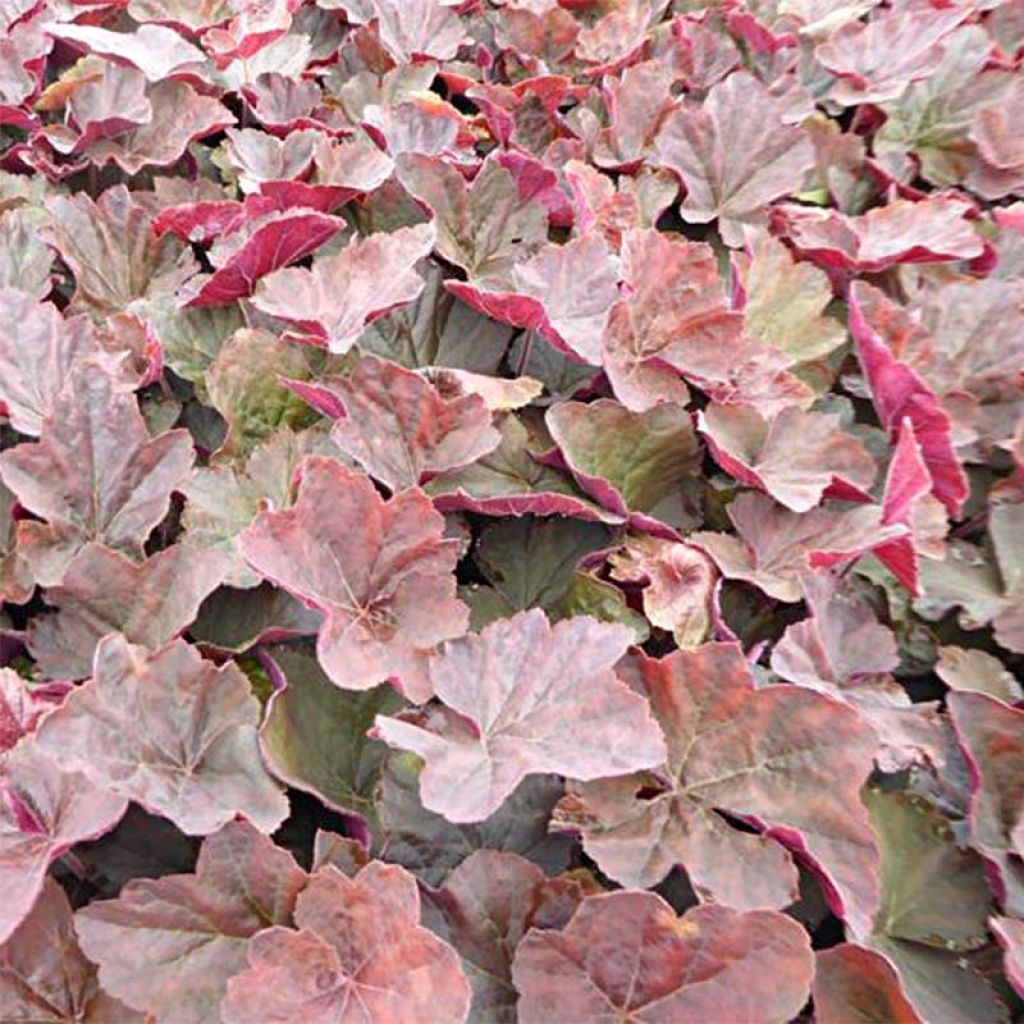

Heuchera villosa Magnum
Heuchera villosa Magnum
Heuchera villosa Magnum
Hairy Alumroot
Why not try an alternative variety in stock?
View all →This plant carries a 12 months recovery warranty
More information
We guarantee the quality of our plants for a full growing cycle, and will replace at our expense any plant that fails to recover under normal climatic and planting conditions.
From €5.90 for pickup delivery and €6.90 for home delivery
Express home delivery from €8.90.
Does this plant fit my garden?
Set up your Plantfit profile →
Description
Heuchera 'Magnum', is a recent French creation that is among the most spectacular heucheras. This surprising descendant of Heuchera villosa, with an evocative name, forms very large leaves of burgundy-purple that come alive with metallic reflections and dark veins as it ages. Its long spring to summer flowering, made up of numerous spikes of tiny white-pink flowers, is an additional asset. With its ever-evolving evergreen foliage, this variety is impressive in the ground and looks lavish in containers.
Heuchera 'Magnum' belongs to the Saxifragaceae family. It is a hybrid of Heuchera villosa, native to the mountains of the eastern United States, obtained in France by Thierry and Sandrine Delabroye. It will reach 30 cm (12 in) in height for the foliage and 60 cm (24 in) in width in 3 to 4 years. This heuchera forms a large, spreading clump. The foliage is the major asset of this evergreen plant: its rounded and lobed leaves with wavy lamina can reach 20 cm (8 in) in diameter, and they have prominent veins. As summer reaches its peak, their burgundy colour fades and the foliage becomes veiled from May-June and continues, depending on the climate, until August. The flowers are small bells that are white when they open and then become pink, and are arranged along an erect stem. This plant has a shallow root system: it withstands heat well but requires a soil that remains moist.
Heuchera 'Magnum' deserves a special place in the garden or on the terrace, always in partial shade and in moist soil. It can be planted in the ground in a bed, in a shaded and cool rockery, or in a pot. When planted in a row in a flower bed, this heuchera, which allows for multiple combinations with other flowering or foliage plants, will bring dynamism to the garden. Pair it with hostas (the 'Empress Wu' hosta, which is giant, will form a superb blue background), grasses, and ferns for a wild effect. It also makes a good companion for shrubs and roses, planted in undergrowth areas. In a shaded rockery, place a light mulch at its feet to contrast with its beautiful foliage. Lastly, it is an ideal ground cover with remarkable colours. Pair this heuchera with the 'Autumn Brides' cultivar or with blue flowers: forget-me-nots, brunneras, corydalis, or lungworts. Heuchera is perfect for filling your pots, containers, and large shaded planters. A good cut flower, the delicate bells of this plant add a lot of lightness to bouquets.
Heucheras with trembling stems and tiny bells were very fashionable in the 19th century in gardens all over Europe. They were nicknamed "the despair of the painter" by the Impressionist painters, perhaps after attempting in vain to depict their colours.
Report an error about the product description
Heuchera villosa Magnum in pictures
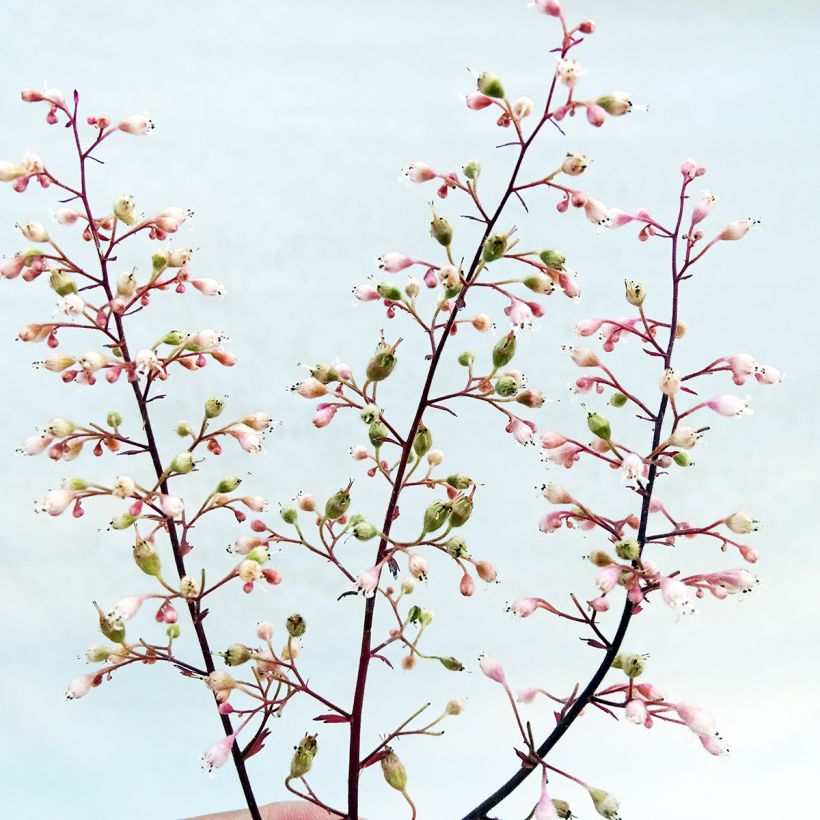



Flowering
Foliage
Plant habit
Botanical data
Heuchera
villosa
Magnum
Saxifragaceae
Hairy Alumroot
Cultivar or hybrid
Other Heuchera
Planting and care
Heuchera 'Magnum' is easy to maintain and thrives in all fresh, fertile, and well-drained soils, in partial shade, but it is imperative that you avoid placing it in full sun. Its strong resemblance to H. villosa gives it good resistance to heat and cold. You should plant it in loose soil that retains moisture, possibly providing mulch. It likes well-drained soil and rocks in and above the ground. However, it does not tolerate very hot and arid conditions. Sandy and poor soils should be avoided. Also, avoid planting it near very vigorous perennials. Heucheras have rather shallow root systems, so you should plant them slightly lower than the crown (the point where the foliage begins). After a few years of growth or when you divide them, you should replant them slightly more deeply, taking care to remove the lignified parts.
Planting period
Intended location
Care
This item has not been reviewed yet - be the first to leave a review about it.
Summer flowering perennials
Haven't found what you were looking for?
Hardiness is the lowest winter temperature a plant can endure without suffering serious damage or even dying. However, hardiness is affected by location (a sheltered area, such as a patio), protection (winter cover) and soil type (hardiness is improved by well-drained soil).

Photo Sharing Terms & Conditions
In order to encourage gardeners to interact and share their experiences, Promesse de fleurs offers various media enabling content to be uploaded onto its Site - in particular via the ‘Photo sharing’ module.
The User agrees to refrain from:
- Posting any content that is illegal, prejudicial, insulting, racist, inciteful to hatred, revisionist, contrary to public decency, that infringes on privacy or on the privacy rights of third parties, in particular the publicity rights of persons and goods, intellectual property rights, or the right to privacy.
- Submitting content on behalf of a third party;
- Impersonate the identity of a third party and/or publish any personal information about a third party;
In general, the User undertakes to refrain from any unethical behaviour.
All Content (in particular text, comments, files, images, photos, videos, creative works, etc.), which may be subject to property or intellectual property rights, image or other private rights, shall remain the property of the User, subject to the limited rights granted by the terms of the licence granted by Promesse de fleurs as stated below. Users are at liberty to publish or not to publish such Content on the Site, notably via the ‘Photo Sharing’ facility, and accept that this Content shall be made public and freely accessible, notably on the Internet.
Users further acknowledge, undertake to have ,and guarantee that they hold all necessary rights and permissions to publish such material on the Site, in particular with regard to the legislation in force pertaining to any privacy, property, intellectual property, image, or contractual rights, or rights of any other nature. By publishing such Content on the Site, Users acknowledge accepting full liability as publishers of the Content within the meaning of the law, and grant Promesse de fleurs, free of charge, an inclusive, worldwide licence for the said Content for the entire duration of its publication, including all reproduction, representation, up/downloading, displaying, performing, transmission, and storage rights.
Users also grant permission for their name to be linked to the Content and accept that this link may not always be made available.
By engaging in posting material, Users consent to their Content becoming automatically accessible on the Internet, in particular on other sites and/or blogs and/or web pages of the Promesse de fleurs site, including in particular social pages and the Promesse de fleurs catalogue.
Users may secure the removal of entrusted content free of charge by issuing a simple request via our contact form.
The flowering period indicated on our website applies to countries and regions located in USDA zone 8 (France, the United Kingdom, Ireland, the Netherlands, etc.)
It will vary according to where you live:
- In zones 9 to 10 (Italy, Spain, Greece, etc.), flowering will occur about 2 to 4 weeks earlier.
- In zones 6 to 7 (Germany, Poland, Slovenia, and lower mountainous regions), flowering will be delayed by 2 to 3 weeks.
- In zone 5 (Central Europe, Scandinavia), blooming will be delayed by 3 to 5 weeks.
In temperate climates, pruning of spring-flowering shrubs (forsythia, spireas, etc.) should be done just after flowering.
Pruning of summer-flowering shrubs (Indian Lilac, Perovskia, etc.) can be done in winter or spring.
In cold regions as well as with frost-sensitive plants, avoid pruning too early when severe frosts may still occur.
The planting period indicated on our website applies to countries and regions located in USDA zone 8 (France, United Kingdom, Ireland, Netherlands).
It will vary according to where you live:
- In Mediterranean zones (Marseille, Madrid, Milan, etc.), autumn and winter are the best planting periods.
- In continental zones (Strasbourg, Munich, Vienna, etc.), delay planting by 2 to 3 weeks in spring and bring it forward by 2 to 4 weeks in autumn.
- In mountainous regions (the Alps, Pyrenees, Carpathians, etc.), it is best to plant in late spring (May-June) or late summer (August-September).
The harvesting period indicated on our website applies to countries and regions in USDA zone 8 (France, England, Ireland, the Netherlands).
In colder areas (Scandinavia, Poland, Austria...) fruit and vegetable harvests are likely to be delayed by 3-4 weeks.
In warmer areas (Italy, Spain, Greece, etc.), harvesting will probably take place earlier, depending on weather conditions.
The sowing periods indicated on our website apply to countries and regions within USDA Zone 8 (France, UK, Ireland, Netherlands).
In colder areas (Scandinavia, Poland, Austria...), delay any outdoor sowing by 3-4 weeks, or sow under glass.
In warmer climes (Italy, Spain, Greece, etc.), bring outdoor sowing forward by a few weeks.




































